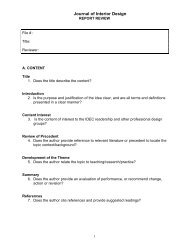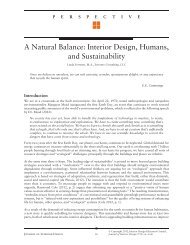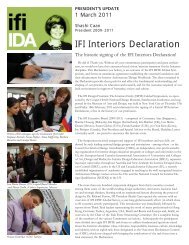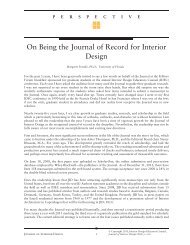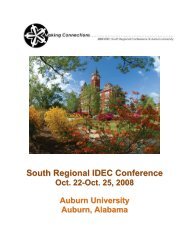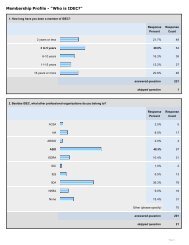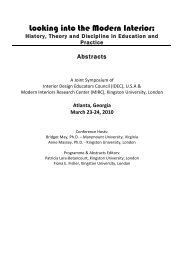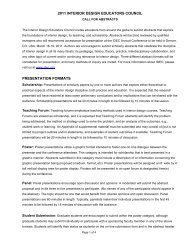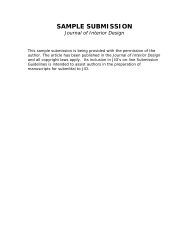P E R S P E C T I V EF<strong>or</strong> those of us who entered the profession through the process of education, experience,<strong>and</strong> exam<strong>in</strong>ation, the public’s lack of knowledge of who we are <strong>and</strong> what we do isextremely frustrat<strong>in</strong>g.Role of the MediaIn addition to these challenges, the media has contributed to the public’s confusion over the role of the <strong>in</strong>teri<strong>or</strong>dec<strong>or</strong>at<strong>or</strong> versus the <strong>in</strong>teri<strong>or</strong> designer. Most of the popular design periodicals do not make a dist<strong>in</strong>ction, n<strong>or</strong>do many of the professional trade magaz<strong>in</strong>es. A study by White <strong>and</strong> Dickson (1993) revealed that the architectsare often given credit f<strong>or</strong> <strong>in</strong>teri<strong>or</strong> w<strong>or</strong>ks even though the firm may employ a team of <strong>in</strong>teri<strong>or</strong> designers. <strong>The</strong>maj<strong>or</strong>ity of these magaz<strong>in</strong>es fail to move beyond the aesthetic realm, <strong>and</strong> few, if any, promote the value ofgood design. An NKBA Position Statement (2008) attempts to further confuse the issue when they state:‘‘We would submit that no <strong>in</strong>dustry is m<strong>or</strong>e readily accessible to the public than the <strong>in</strong>teri<strong>or</strong> designprofession. ... [T]here are numerous consumer publications, websites <strong>and</strong> television programs(<strong>and</strong> netw<strong>or</strong>ks such as HGTV) which educate the public on the role of <strong>in</strong>teri<strong>or</strong> designers <strong>and</strong> thequalifications of the various discipl<strong>in</strong>es. Surely the public does not lack the ability to make <strong>in</strong>f<strong>or</strong>medchoices about who they reta<strong>in</strong> f<strong>or</strong> design services.’’ (p. 4)A study by Waxman <strong>and</strong> Clemons (2007) expl<strong>or</strong>ed the <strong>in</strong>fluence of design-related ‘‘reality’’ shows on students’perceptions of the design profession. <strong>The</strong>y found that the ability to discern the l<strong>in</strong>e between the ‘‘constructedreality’’ <strong>and</strong> the ‘‘actual reality’’ was often fuzzy <strong>in</strong> the eyes of the viewers, <strong>and</strong> these mixed messages were be<strong>in</strong>gtransmitted to the new students enter<strong>in</strong>g <strong>in</strong>teri<strong>or</strong> design programs as well as the public. Seni<strong>or</strong>-level studentsvoiced the concern that these shows tarnished the image of <strong>in</strong>teri<strong>or</strong> designers. After watch<strong>in</strong>g a number ofdesign-related reality shows, Mart<strong>in</strong> concluded that one of the myths perpetuated about the profession wasthat ‘‘anyone can be an <strong>in</strong>teri<strong>or</strong> designer’’ (cited <strong>in</strong> Waxman & Clemens, 2007, p. vii; see also Bowles, 2008).F<strong>or</strong> those of us who entered the profession through the process of education, experience, <strong>and</strong> exam<strong>in</strong>ation,the public’s lack of knowledge of who we are <strong>and</strong> what we do is extremely frustrat<strong>in</strong>g. It is no wonder thatsome are advocat<strong>in</strong>g yet another name change to better def<strong>in</strong>e our role <strong>in</strong> creat<strong>in</strong>g the built environment.Perceptions of Occupational StatusAll this suggests that occupational stereotyp<strong>in</strong>g is one of the problems we must overcome <strong>in</strong> def<strong>in</strong><strong>in</strong>g the<strong>in</strong>teri<strong>or</strong> design profession. Lipton, O’Conn<strong>or</strong>, Terry, <strong>and</strong> Bellamy (1991) def<strong>in</strong>e occupational stereotyp<strong>in</strong>g as ‘‘apreconceived attitude about a particular occupation, about people who are employed <strong>in</strong> that occupation, <strong>and</strong>about one’s own suitability f<strong>or</strong> that occupation’’ (p. 129). A study by Thielbar <strong>and</strong> Feldman (1969) concludedthat stereotypes guide the assessment of occupational prestige. <strong>The</strong>y further suggest ‘‘representations of society<strong>in</strong> fictional writ<strong>in</strong>g, television drama, <strong>and</strong> movies often reflect social life through occupational stereotypes.Sometimes it is not the <strong>in</strong>cumbent but the position that is stereotyped’’ (p. 67). Thielbar <strong>and</strong> Feldman’sf<strong>in</strong>d<strong>in</strong>gs concern<strong>in</strong>g occupational stereotypes <strong>and</strong> perceptions of status <strong>or</strong> prestige were later confirmed <strong>in</strong>research conducted by Oswald (2003).Grimm <strong>and</strong> Kronus (1973) have developed an analytical framew<strong>or</strong>k f<strong>or</strong> study<strong>in</strong>g occupations <strong>in</strong> their socialenvironments, tak<strong>in</strong>g <strong>in</strong>to account both objective (i.e., sex distribution, <strong>in</strong>come, education) <strong>and</strong> subjectivecharacteristics (i.e., group ideologies <strong>and</strong> value systems). By draw<strong>in</strong>g on previous research, the auth<strong>or</strong>s showthat assessments of occupational status <strong>and</strong> stereotypes tend to be unif<strong>or</strong>m across groups <strong>and</strong> time. Grimm<strong>and</strong> Kronus suggest that occupations that do not achieve full professional status have failed to conv<strong>in</strong>ce thepublic that they have a scientific basis of knowledge, a lengthy tra<strong>in</strong><strong>in</strong>g period, a strong service commitment,<strong>and</strong> autonomous w<strong>or</strong>k<strong>in</strong>g conditions. On a m<strong>or</strong>e positive note, the auth<strong>or</strong>s discuss how both law <strong>and</strong> medic<strong>in</strong>eupgraded their images beg<strong>in</strong>n<strong>in</strong>g <strong>in</strong> the latter half of the n<strong>in</strong>eteenth century by focus<strong>in</strong>g on the af<strong>or</strong>ementionedcriteria. <strong>Interi<strong>or</strong></strong> design has attempted to do the same, but as yet has not been successful.Journal of <strong>Interi<strong>or</strong></strong> <strong>Design</strong> xiiiVolume 35 Number 1 2009
P E R S P E C T I V E<strong>The</strong> study concluded that Western designers should rightfully be concerned about theirlack of recognition <strong>and</strong> underst<strong>and</strong><strong>in</strong>g. Further, ‘‘design does not carry the same level ofprestige <strong>and</strong> social st<strong>and</strong><strong>in</strong>g as eng<strong>in</strong>eer<strong>in</strong>g <strong>or</strong> architecture, even though the impact of thedesigner on society may be equally significant’’Whitfield <strong>and</strong> Smith (2003) conducted a study to determ<strong>in</strong>e how society perceived the design professions(i.e., graphic design, <strong>in</strong>dustrial design, fashion design, <strong>in</strong>teri<strong>or</strong> design, <strong>and</strong> furniture design). Six dimensionswere used to measure the perception of social st<strong>and</strong><strong>in</strong>g: (1) level of social st<strong>and</strong><strong>in</strong>g; (2) education level;(3) <strong>in</strong>come level; (4) amount of responsibility; (5) usefulness as a profession; <strong>and</strong> (6) prop<strong>or</strong>tion of women<strong>in</strong> the profession. On the basis of the premise that ‘‘design suffers from an identity crisis—no one is quitesure what it is,’’ subjects both with <strong>and</strong> without design tra<strong>in</strong><strong>in</strong>g were drawn from Australia <strong>and</strong> SouthK<strong>or</strong>ea (p. 116). <strong>The</strong> auth<strong>or</strong>s determ<strong>in</strong>ed that <strong>in</strong> Western societies, <strong>in</strong>come <strong>and</strong> education were imp<strong>or</strong>tantpredict<strong>or</strong>s of occupational prestige. <strong>The</strong> design subjects consistently rated the design occupations higher thanthe public group. With the exception of graphic <strong>and</strong> <strong>in</strong>dustrial design, the Australian public group rated allof the design professions low <strong>in</strong> occupational prestige, <strong>and</strong> all respondents ranked the design professionslow on the service to the community dimension. In addition, both design-educated <strong>and</strong> public Australiangroups considered fashion design <strong>and</strong> <strong>in</strong>teri<strong>or</strong> design as ‘‘female’’ occupations, which Grimm <strong>and</strong> Kronus(1973) suggest negatively affects the perceived status of these occupations. <strong>The</strong> study concluded that Westerndesigners should rightfully be concerned about their lack of recognition <strong>and</strong> underst<strong>and</strong><strong>in</strong>g. Further, ‘‘designdoes not carry the same level of prestige <strong>and</strong> social st<strong>and</strong><strong>in</strong>g as eng<strong>in</strong>eer<strong>in</strong>g <strong>or</strong> architecture, even though theimpact of the designer on society may be equally significant’’ (Whitfield & Smith, 2003, p. 133).It is w<strong>or</strong>th spend<strong>in</strong>g a few m<strong>in</strong>utes exam<strong>in</strong><strong>in</strong>g the effect of gender on perceived occupational status. Botheng<strong>in</strong>eer<strong>in</strong>g <strong>and</strong> architecture are considered by many to be predom<strong>in</strong>antly male professions although <strong>in</strong>creas<strong>in</strong>gnumbers of females are pursu<strong>in</strong>g these degrees. By contrast, the roots of the <strong>in</strong>teri<strong>or</strong> design profession via<strong>in</strong>teri<strong>or</strong> dec<strong>or</strong>ation were predom<strong>in</strong>antly female. Massey (2008) details the emergence of <strong>in</strong>teri<strong>or</strong> dec<strong>or</strong>ation,which catered primarily to the rich <strong>and</strong> famous so that they might express their power <strong>and</strong> prestige. Shenotes, however, that <strong>in</strong>teri<strong>or</strong> dec<strong>or</strong>ation was one of the few professions led by women, particularly womenof ‘good taste,’ which she suggests has led to a cont<strong>in</strong>u<strong>in</strong>g lack of occupational prestige <strong>or</strong> ‘‘seriousness’’ (seealso Turp<strong>in</strong>, 2007, p. 124).One can only wonder how much these early female-based roots <strong>in</strong> <strong>in</strong>teri<strong>or</strong> dec<strong>or</strong>at<strong>in</strong>g have cont<strong>in</strong>ued to<strong>in</strong>fluence the occupational stereotypes of the <strong>in</strong>teri<strong>or</strong> design profession. Oswald’s research (2003) revealed thatoccupational titles associated with men were perceived as m<strong>or</strong>e prestigious than those associated primarilywith women. Further, men <strong>and</strong> women did not differ <strong>in</strong> their evaluations of these occupations. In particular,Oswald noted that architecture was perceived as an occupation mostly associated with men, <strong>and</strong> her researchconfirmed the expectation that sex-based occupational stereotyp<strong>in</strong>g still exists. Thus, the question mustbe posed: If we changed our name to <strong>in</strong>teri<strong>or</strong> architecture, would we automatically ga<strong>in</strong> m<strong>or</strong>e perceivedoccupational status as a profession, <strong>or</strong> does the perception of high occupational status have to be earned?Identity <strong>in</strong> the W<strong>or</strong>kplaceAs documented by Mart<strong>in</strong> (2008), ‘‘<strong>Interi<strong>or</strong></strong> design has w<strong>or</strong>ked f<strong>or</strong> the past 50-plus years to ga<strong>in</strong> identity<strong>in</strong> three key areas: the w<strong>or</strong>kplace, the legal arena, <strong>and</strong> the public’s op<strong>in</strong>ion’’ (p. 10). A recent panel ofleaders from International <strong>Interi<strong>or</strong></strong> <strong>Design</strong> Association (IIDA) <strong>and</strong> American Institute of Architects (AIA)acknowledged the imp<strong>or</strong>tance <strong>and</strong> necessity f<strong>or</strong> collab<strong>or</strong>ation <strong>in</strong> the w<strong>or</strong>kplace (Bowles, 2007). Acc<strong>or</strong>d<strong>in</strong>gto architect Richard Logan, ‘‘<strong>The</strong>re has always been collab<strong>or</strong>ation on <strong>in</strong>teri<strong>or</strong> projects, but the nature ofthe <strong>in</strong>teraction has become m<strong>or</strong>e respectful <strong>and</strong> symbiotic as <strong>in</strong>teri<strong>or</strong> design education has become m<strong>or</strong>eprofessional <strong>and</strong> broader-based, <strong>and</strong> as licens<strong>in</strong>g has become m<strong>or</strong>e prevalent’’ (Bowles, 2007, p. 10). Massey(2008) contends that by upgrad<strong>in</strong>g its educational st<strong>and</strong>ards, the <strong>in</strong>teri<strong>or</strong> design profession is ga<strong>in</strong><strong>in</strong>g m<strong>or</strong>estature <strong>and</strong> is com<strong>in</strong>g <strong>in</strong>to its own as a separate <strong>and</strong> dist<strong>in</strong>ct discipl<strong>in</strong>e. <strong>The</strong> Foundation f<strong>or</strong> <strong>Interi<strong>or</strong></strong> <strong>Design</strong>Journal of <strong>Interi<strong>or</strong></strong> <strong>Design</strong> xivVolume 35 Number 1 2009




